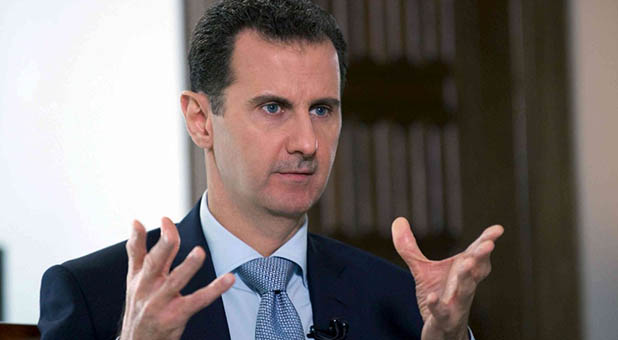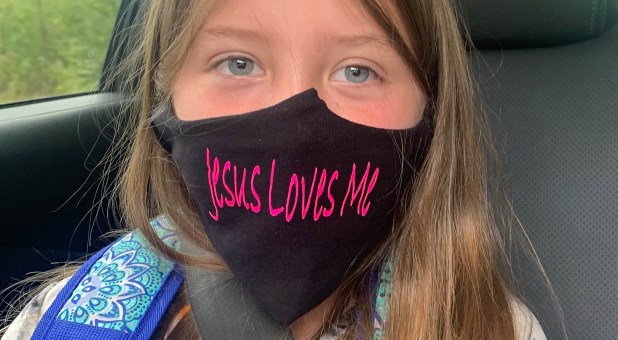Tuesday, senior White House officials briefed members of the media with a detailed description of the evidence the Trump administration says proves beyond all shadow of doubt Bashar al-Assad ordered the chemical weapons attack on his own people.
What they shared they said carried a “high degree of certainty” within the administration. It also destroys the talking points of a number of the voices that have been critical of President Donald Trump’s decision to launch cruise missile strikes against the Syrian airbase from which the chemical attacks were launched.
The first official, who cannot be identified because the briefing was given on background, stated:
What we’ve done here is we’ve declassified a lot of intelligence with great thanks to our colleagues in the intelligence community so that we can be very forthcoming with you about the amount that we know about this attack and why we believe the Russian and Syrian narratives are false. And we think it’s really important for you to understand the depth of information that we have that supports this narrative.
I would say that since we started coming forward, in the immediate wake of the attack, all of the way through to today, we continued to get additional information. And the information we get about this attack continues to be clear and consistent with our understanding of the attack, starting on the day of the attack, April 4th, and working all the way through today.
And I would say we, even as recently as last night, for today, declassified additional information that, again, lends additional weight and credibility to the narrative I want to share with you today.
The information we have downgraded and declassified includes a wide body of open-source material, both social media accounts. It includes open-source videos, reporting, open-source imagery, et cetera, as well as our own geospatial intelligence, our signals intelligence and it includes physiological samples of victims of the attack. And again, all of that tells a very clear and consistent story about what we think happened.
So to be clear, based on the pro-opposition social media reporting, those reports indicate that the chemical attack began in Khan Sheikhun at about 6:55 local time on April 4th. Our information makes quite clear that the attack came from SU-22 fixed-wing aircraft out of the Shayrat airfield, which is regime-controlled. These aircraft were in the vicinity of Khan Sheikhun for about 20 minutes before reports of the chemical attack came out, and they vacated the area shortly after the attack. And I think some of you have seen the information that we shared previously about the tracks of those aircraft that came out of the Khan Sheikhun airfield—or out of the Shayrat airfield, lingered over Khan Sheikhun, and came back to that airfield.
In addition, we have information that suggests that personnel historically associated with the chemical weapons program were at Shayrat airfield in late March preparing for this attack. On the dates surrounding the attack, and the day of the attack, they were again present at that airfield. Hours after the attack, there were hundreds of accounts of victims of the particular chemical weapons attack.
The victimology, the symptomology of those victims is very consistent with nerve agent and sarin exposure. And now, as I will note, we do have physiological samples from a number of victims that confirm sarin exposure. The symptomology was quite consistent. We saw miosis, or pin-point pupils. We see frothing at the noise and mouth, twitching. All of those are consistent with nerve agent. They are not consistent with chlorine.
Also, the victimology shows that those people don’t have other wounds or injuries that would be consistent with a conventional attack.
I would note, as well, that another clear symptom of sarin or nerve agent exposure is that the secondary responders also started to have symptoms consistent with sarin exposure. And those were the people that were there that took in the victims, that were touching them, that were removing their clothing. Some of those also passed out and had other symptoms of sarin exposure.
So by about 12:15 local time, the open source was very clear: It showed images of dead children of varying ages. And then we started to get accounts of the hospital, where some of those victims were being taken, being bombed at about 1:10 p.m. local. It showed, again, victims flooding to that particular hospital before there was a conventional attack against that hospital.
The impact craters that we have in imagery and open source show conventional weapons being used around that hospital, not chemical weapons there. The other information we have shows that leakage around the actual weapon that we think the sarin came from, not explosive debris that we would expect if it had been an explosive munition that it hit chemicals or something that would be consistent with a Russian attack. And again, we think that is not true …
We also think—some people have alleged that videos had been fabricated, that a lot of this information had been fabricated. The absolute massive data we have, and all the different vehicles we’ve gotten it from—open-source videos, to victim accounts, to imagery, to signals intelligence—it’s just too massive for really any intelligence organization to fabricate in that short a period of time. We just think that’s not a feasible explanation.
And then we did confirm that some of the videos that were shot of the account, we did go to independently confirm that the times at which those videos were taken were consistent with the times of the attack and not from prior footage of other attacks, other places.
So let me walk through a little bit—and, I would also note the World Health Organization came up with similar analysis on April 5th. It, too, felt that the victims had been exposed to nerve agent based on the same kind of symptomology along the board. And we do expect that as others continue—and we would expect we are looking forward to the OPCW’s fact-finding mission, looking into this event itself, and we think it’s really important for them to get out there, for them to have access to the site of the attack, to the airfield, to other places that might be affiliated. And we expect that any samples they find will again be consistent with what we’ve found so far.
In terms of the Russian narrative—and I’ll get back to your question about them and the inconsistency—across the board, starting in 2013 and then since, we’ve seen both the Russians and the Syrians have a very clear campaign to try to obfuscate the nature of attacks, the attackers and what has happened in any particular incident.
They’ve thrown out a bunch of potential agents, a bunch of potential responsible or accountable parties. And, often, their own information is inconsistent with their own narrative.
They certainly have dismissed the allegations of a chemical weapons attacking Khan Sheikun. They called it a “prank of a provocative nature.” But again, we don’t think it’s remotely possible for the Syrians or the Russians to have fabricated this much information so fast and so consistently on this attack.
I’d also note that we’ve, of course, got extensive media observers and we have our own intelligence information. And the intelligence information and the accounts we’ve gotten from our partners, again, suggest very similar outcomes in this attack.
They noted, as I said—the Russians did—that this was a regime attack against a munitions depot, and that perhaps that terrorists had been holding chemical munitions that were attacked and then exploded from there. As I noted, we think that the information is inconsistent with that narrative. There is, as I said, leakage, and not in this hospital or this area where they said a building was attacked, but in a separate place where we can see the leakage from that munition. It is inconsistent with where the Russians would say that this attack happens and where the gas came from. And similarly, again, it’s leakage; it does not show explosive dissemination of the chemicals. And we don’t see a building, again, with that chemical residue we would expect if the Russian narrative was true.
The official declined to comment on previous news reports that suggested Russia was aware of the chemical attack beforehand but did say the media would be updated once the intelligence assessments on that aspect of the situation were completed. He did say, however, that it seemed clear the Russian government was attempting to cover up what happened:
We’re still looking into that, into the particulars of that question. And there’s not a consensus on our side about the extent or how to interpret the information that we have and continue to get.
However, what we do know from looking at a history of the Russian military and the Syrian military operating together for the better part of two years now closely, since the Russian advisory mission and assistance mission began in earnest in 2015. And in addition, two militaries that have a decades-long support relationship. Based on that historical pattern, we’ve seen that these two militaries operate very closely, even down to an operational and tactical level.
And so considering the fact that there were Russian forces co-located with Syrian forces at the Shayrat airfield, in addition to many other installations—many other Syrian regime installations around the country—we do think that it is a question worth asking the Russians about how is it possible that their forces were co-located with the Syrian forces that planned, prepared and carried out this chemical weapons attack at the same installation, and did not have foreknowledge.
After some back-and-forth with reporters over the cover-up allegations, the official returned to his explanation of the Trump administration’s reasons for why the Russian-Syrian narrative is false:
Moscow, as I noted, said that the release of chemicals was caused by the terrorist—a strike on a terrorist ammunition depot, but a Syrian military source told Russian state media on April 4th that regime forces had not carried out any strike in Khan Sheikhun, which contradicted Russia’s claim directly.
An open-source video shows where we believe the chemical munition landed—again, not on a facility with weapons, but in the middle of a street in the northern section of Khan Sheikhun. The imagery of that site from April 6th, after the allegation, shows a crater in the road that corresponds to the open-source video, so we can track to where we think that particular munition was.
The Russians also allege that the terrorists—this was a bombing on a terrorist ammunition depot. We do not assess and have not assessed that ISIS or other terrorists in the area have sarin. So while ISIS is using sulfur mustard and we’ve documented that quite well, and certainly oppose chemical weapons use by any actor, state or non-state, and are working, of course, to be able to push back ISIS chemical use as well— it is quite clear to us that in this case this is not a terrorist holding of sarin or terrorist use of sarin. But we do know that the Syrian regime has sarin, that it used it in the 2013 attack, and there are outstanding questions from the Organization for the Prohibition of Chemical Weapons that make quite clear that Syria has not fully come clean on the locations, facilities, types of agents or personnel involved with its chemical weapons program, causing us additional questions on what’s there.
I think it’s a clear pattern of deflecting blame. We’ve seen this in multiple accounts, including when the OPCW-U.N. joint investigative mechanism came out with reports in August and October of last year identifying Syria as culpable in three chemical weapons attacks. In these three cases these were chlorine attacks. They were from a different airfield here. The United States did come out with designations on personnel affiliated with that attack on that airfield to condemn that use, as well.
This is quite concerning, given that the Russians were part of setting up the deal by which Syria was supposed to give up its chemical weapons. It was party to the deal to create the Joint Investigative Mechanism to investigate these attacks. The JIM did come forward with clear attribution calls, and Russia has refused to accept those along the way.
Another senior administration official described what the administration believes was the Syrian reason for the chemical weapons attack as well:
In the middle of March, opposition forces launched an offensive from Southern Idlib province toward the major city of Hama, which is a strategic city in Syria. It’s Syria’s third city, and it’s also the location of a key Syrian regime airbase that has been crucial for the regime and the forces that support it for projecting power from central Syria, both along the western spine, from Aleppo down to the south, and also further to the east to support operations in Palmyra. So that is an airbase that the regime had to calculate that it could not lose.
The opposition offensive approach was able to penetrate to within just a couple of miles of that strategic airbase and also threatened the Hama population center within just a few miles.
At that point, the regime we think calculated that with its manpower spread quite thin, trying to support both defensive operations and consolidation operations in Aleppo and along that north-south spine of western Syria, and also trying to support operations which required it to send manpower and resources east toward Palmyra, we believe that the regime probably calculated at that point that chemical weapons were necessary in order to try to make up for the manpower deficiency.
That’s why we saw, we believe, multiple attacks of this nature against locations that the regime probably determined were support areas for the opposition forces that were near Hama—for example, in the town of Al-Tamanah and then in the town of Khan Sheikhun, both of which are in what would be, in military terms, the rear area for the opposition forces that were on the front line.
So we believe certainly that there was an operational calculus that the regime and perhaps its Russian advisors went through in terms of the decision-making.
A third administration official discussed the international impact of these findings, particularly as it applies to the United Nations and the Organization for the Prohibition of Chemical Weapons:
It’s incredibly important that we speak with one voice at the United Nations and at the Organization for the Prohibition of Chemical Weapons. We need to speak with a clear message: That chemical weapons use of any kind, by any actor, is absolutely intolerable. That is our goal, and we need to do everything we can, collectively, to make sure that comes across clearly.
We’re working with all of our partners, and we’ve made this message clear to the Russians as well, and will continue to do so, that we believe it’s in no state’s interest that any actor uses chemical weapons. {eoa}
See an error in this article?
To contact us or to submit an article





















